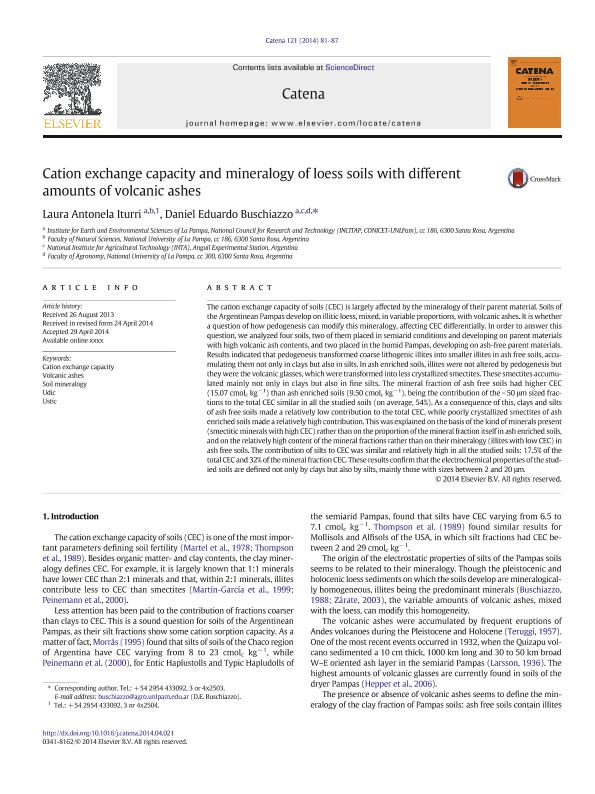Mostrar el registro sencillo del ítem
dc.contributor.author
Iturri, Laura Antonela

dc.contributor.author
Buschiazzo, Daniel Eduardo

dc.date.available
2018-01-26T17:30:50Z
dc.date.issued
2014-05
dc.identifier.citation
Iturri, Laura Antonela; Buschiazzo, Daniel Eduardo; Cation exchange capacity and mineralogy of loess soils with different amounts of volcanic ashes; Elsevier; Catena; 121; 5-2014; 81-87
dc.identifier.issn
0341-8162
dc.identifier.uri
http://hdl.handle.net/11336/34696
dc.description.abstract
The cation exchange capacity of soils (CEC) is largely affected by the mineralogy of their parent material. Soils of the Argentinean Pampas develop on illitic loess, mixed, in variable proportions, with volcanic ashes. It is whether a question how pedogenesis can modify this mineralogy, affecting CEC differentially. In order to answer this question, we analyzed four soils, two of them placed in semiarid conditions and developing on parent materials with high volcanic ash contents, and two placed in the humid Pampas, developing on ash-free parent materials. Results indicated that pedogenesis transformed coarse lithogenic illites into smaller illites in ash free soils, accumulating them in clays but also in silts. In ash enriched soils, illites were not altered by pedogenesis but they were the volcanic glasses, which were transformed into less crystallized smectites. These smectites accumulated mainly in clays but also in fine silts. The mineral fraction of ash free soils had higher CEC (15.07 cmolc kg-1) than ash enriched soils (9.50 cmolc kg-1), being the contribution of the < 50 μm sized fractions to the total CEC similar in all studied soils (on average, 54 %). As a consequence of this, clays and silts of ash free soils made a relative low contribution to the total CEC, while poorly crystallized smectites of ash enriched soils made a relative high contribution. This was explained on the basis of the kind of minerals present (smectitic minerals with high CEC) rather than on the proportion of the mineral fraction itself in ash enriched soils, and on the relative high content of the mineral fractions rather than on their mineralogy (illites with low CEC) in ash free soils. The contribution of silts to CEC was similar and relatively high in all studied soils: 17.5% of the total CEC and 32% of the mineral fraction CEC. These results confirm that the electrochemical properties of the studied soils are not only defined by clays but also by silts, mainly those with sizes between 2 and 20 µm.
dc.format
application/pdf
dc.language.iso
eng
dc.publisher
Elsevier

dc.rights
info:eu-repo/semantics/openAccess
dc.rights.uri
https://creativecommons.org/licenses/by-nc-nd/2.5/ar/
dc.subject
Cation Exchange Capacity
dc.subject
Volcanic Ashes
dc.subject
Soil Mineralogy
dc.subject
Udic
dc.subject
Ustic
dc.title
Cation exchange capacity and mineralogy of loess soils with different amounts of volcanic ashes
dc.type
info:eu-repo/semantics/article
dc.type
info:ar-repo/semantics/artículo
dc.type
info:eu-repo/semantics/publishedVersion
dc.date.updated
2018-01-16T18:24:12Z
dc.journal.volume
121
dc.journal.pagination
81-87
dc.journal.pais
Países Bajos

dc.journal.ciudad
Ámsterdam
dc.description.fil
Fil: Iturri, Laura Antonela. Consejo Nacional de Investigaciones Científicas y Técnicas. Instituto de Ciencias de la Tierra y Ambientales de La Pampa. Universidad Nacional de La Pampa. Facultad de Ciencias Exactas y Naturales. Instituto de Ciencias de la Tierra y Ambientales de La Pampa; Argentina. Universidad Nacional de La Pampa. Facultad de Ciencias Exactas y Naturales; Argentina
dc.description.fil
Fil: Buschiazzo, Daniel Eduardo. Consejo Nacional de Investigaciones Científicas y Técnicas. Instituto de Ciencias de la Tierra y Ambientales de La Pampa. Universidad Nacional de La Pampa. Facultad de Ciencias Exactas y Naturales. Instituto de Ciencias de la Tierra y Ambientales de La Pampa; Argentina. Instituto Nacional de Tecnología Agropecuaria. Centro Regional La Pampa-San Luis. Estación Experimental Agropecuaria Anguil; Argentina. Universidad Nacional de La Pampa. Facultad de Agronomía; Argentina
dc.journal.title
Catena

dc.relation.alternativeid
info:eu-repo/semantics/altIdentifier/url/https://www.sciencedirect.com/science/article/pii/S0341816214001301
dc.relation.alternativeid
info:eu-repo/semantics/altIdentifier/doi/http://dx.doi.org/10.1016/j.catena.2014.04.021
Archivos asociados
